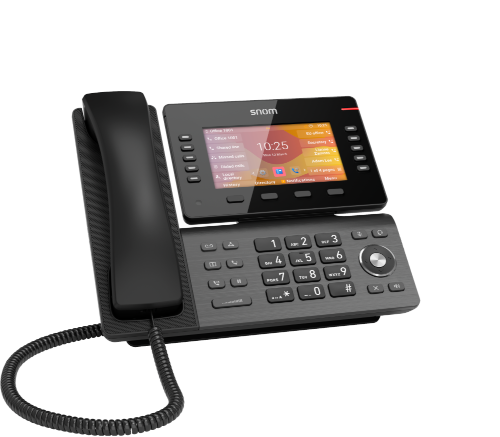Back

All products
Desk phones
We offer variety from four telephone series
Wireless Phones
Mobile DECT telephony at the highest level
Hospitality Phones
Discover our phone series for the hotel and hospitality industry.
Headsets
Hands free with great sound
Audio Conference Devices
Let's talk about it
Location Gateway
Locate people and objects anytime and anywhere
Special Application Device
Our devices for special applications
Accessories
WiFi, DECT-Dongle and more
Back

Technologies
Snom equips its various products with common, modern technologies to produce maximum compatible devices.
Wireless connections
DECT Single- and Multicell, DECT Beacons & Alarms, Bluetooth, WiFi & NFC
Audio
Codecs & Frequency Bands
Software
Firmware, SRAPS, Phonelink & CO.
Security
Security in the age of VoIP

Guide
The guide is intended to provide information on which Snom devices can be used in everyday situations and what to look for to get the best communication solution.
Back

Guide
The guide is intended to provide information on which Snom devices can be used in everyday situations and what to look for to get the best communication solution.
Work environments
We recommend solutions that fit your environment
Devices
Here we give you a brief overview of our entire equipment portfolio
Phone systems
We give you tips for choosing a suitable telephone system
Applications
Find out which solutions VoIP telephony has to offer

Services
Snom offers suitable and complementary services for the devices and solutions.
Back

Services
Snom offers suitable and complementary services for the devices and solutions.
SRAPS
Smart Device Management, whether on the road or from the office
Customise desk phones
Make it your phone
Faceplates for Snom Hospitality Telephones
Design your own faceplates

Partner
Being a Snom Partner brings many advantages. Discover what is most important to you.
Back

Partner
Being a Snom Partner brings many advantages. Discover what is most important to you.
Discover the partner program
Learn about the benefits of being a Snom Partner
Become a Partner
Becoming a Snom Partner is easy
Partner Portal
What to expect in our Partner Lounge
PBX Partner
Discover which PBX partners are compatible with our Snom devices
Distributors
Find the right partner distributor here.

Support
Here you will find support for the optimal use of our devices and solutions. We provide answers to questions, be they of a practical or technical nature.
Back

Support
Here you will find support for the optimal use of our devices and solutions. We provide answers to questions, be they of a practical or technical nature.
Help Center
The most important FAQ and how-to articles for pragmatic and quick support.
Firmware
Are your Snom devices up to date?
Hardware defect
What to do if a Snom device is defective.
Create Helpdesk Ticket
This is how Snom partners can get help.
Snom Apps
Snom Apps Help

About us
What you always wanted to know about Snom, if you want to find out what is new at Snom and much more.
Back

About us
What you always wanted to know about Snom, if you want to find out what is new at Snom and much more.
Discover Snom
Find out who Snom is and which values we stand for.
News
National and international news and press releases can be found here.
Appointments & Events
Webinars, trade fairs and other events can be found here.
Snom Green Strategy
Snom takes sustainability and ecological action seriously and has been following a "green path" for some time.
Our History
Check out our milestones, from the world's first SIP phone until today.
Management
Who are the leaders

Contact
We look forward to talking to you. We make it easy for you to get in touch with us.
Back

Contact
We look forward to talking to you. We make it easy for you to get in touch with us.
Contact person
Here you can find the appropriate contact person in Snom Sales.
Company locations
We are on site in many countries around the world. We show you where exactly.
Reporting Vulnerabilities
You have found a vulnerability in one of our products? Tell us about it.
Authorised Repair Partner
Become a Snom Authorised Repair Partner

Jobs
Working at Snom is like finally arriving. We show you life as a "Snommie".
Back

Jobs
Working at Snom is like finally arriving. We show you life as a "Snommie".
Open positions
We look forward to meeting you
Benefits at a glance
We take care of our Snommies.
HR Team
Get to know your future HR team.








